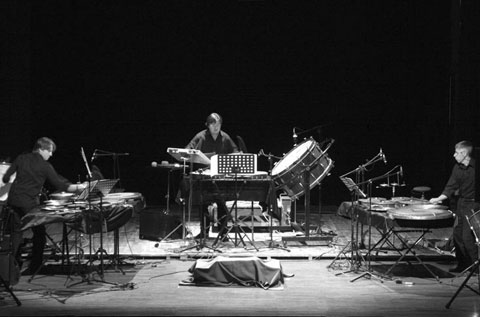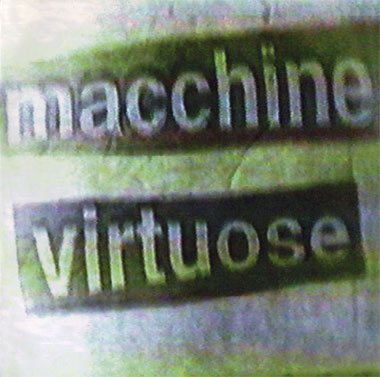Macchine Virtuose
part I – Aura in Visibile
part II – Aleph con Zero
part III – Discussione del 3000
part IV – Anima di Metallo
performers
ARS LUDI
Antonio Caggiano – percussion
Gianluca Ruggeri – percussion
Alessandro Tomassetti – percussion
Oscar Pizzo- piano
Suyun Kim – piano
Manuel Zurria – flute
Luigi Ceccarelli – sound direction
Gianfranco Lucchino – sound and multivision design
Elly Nagaoka – images
Renato Piselli – multivision realization
sound design EDISON Studio – Roma
duration 60′
Edipan editions
commission: Festival Nuova Musica Italiana – Roma
1st performance: Roma, Acquario Romano
“Progetto Musica ’94” – October 27, 1994
This concert is made up of four pieces which are scored for traditional instruments together with electronic or Midi instruments and Live Electronics.
All these works have been composed by Luigi Ceccarelli since 1990. Even though each of the pieces has a specific musical idea, it is the author’s aim to present them together in a whole performance, a single unitary sonic event, while mantaining the poetics of each one.
The players have followed the progress from the experimental phases to the final stages in order to improve the technical aspects of the pieces.
The electronic sound processing is concieved as an extension of the natural instrumental sound, creating new timbral and counterpunctual possibilities thereby constructing new imaginary sonic spaces.
Gianfranco Lucchino created in the staging of each work a specific atmosphere extending the basic musical concepts over the physical dimensions of space.
Different from the traditional concert setting where the visual, sound and space elements are seldom considered closely related, the staging of this concert creates, for each piece, the correct ambience and, at the same time, transforms the overall interaction of sound, movement and light into single global event. It is not the intent to make the concert a kind of musical theatre but rather to create an ideal situation for its perception and enjoyment.



“Aura In Visibile” treats the piano as a sound source which is put in vibration by external mechanical exciters. In this environment the flute’s sound and the pianist’s action wander in search of subtle variations inside the resonance.The flutist and pianist are like two explorers who try to capture the most stirring resonance of this vibrating universe and convey it to the listeners.
The vibration of the string is obtained by a mechanical system of exciters (projected by the composer) which is controlled in real time by computer.
“Aleph con Zero” includes sounds of two marimbas and a prepared piano. As the piece unfolds, the amplified sounds become increasingly alien to the nature of live instruments, expanding towards a more percussive character.
Aleph con Zero, is formed by the superimposition of simple rhythmic, visual and sound patterns, which create a single complex texture. The diversity between the rhythms gives rise to a very dense sound result, at times apparently inextricable.
In “Anima di Metallo” (Metal soul), metallic percussions and instruments from diverse cultures have been assembled: Thai and Bali gongs, Paiste gongs, Chinese cymbals, heavy bells together with three bass drums.
The composition is a juxtaposition of simple rhythms and time events with varrying tempos and asymmetrical accents all in the same meter creating a complex structure. The aim of this piece is to contribute to the onging work of craftsmen and musicians who, for centuries, have searched for their inner most manings within the vibrating metals.
CD – Macchine Virtuose
Edipan CCD 3062
duration: 55′ – 1996
(Aura in Visibile, Aleph con Zero, Discussione del 3000, Anima di Metallo)
By the CD online
In “Discussione del 3000” the two percussionists produce, through their instrumental technique, an abstract verbal discussion formed of phonetic sounds.
This piece, inspired by Futurism, is part of the score composed for the dance music “Anihccam” with choreography by Lucia Latour. The wowel sounds are extracts from “Verbalizzazione Astratta di Signora” by poet and painter Fortunato Depero and the talking voice which is processed by computer is that of the italian painter Achille Perilli.


